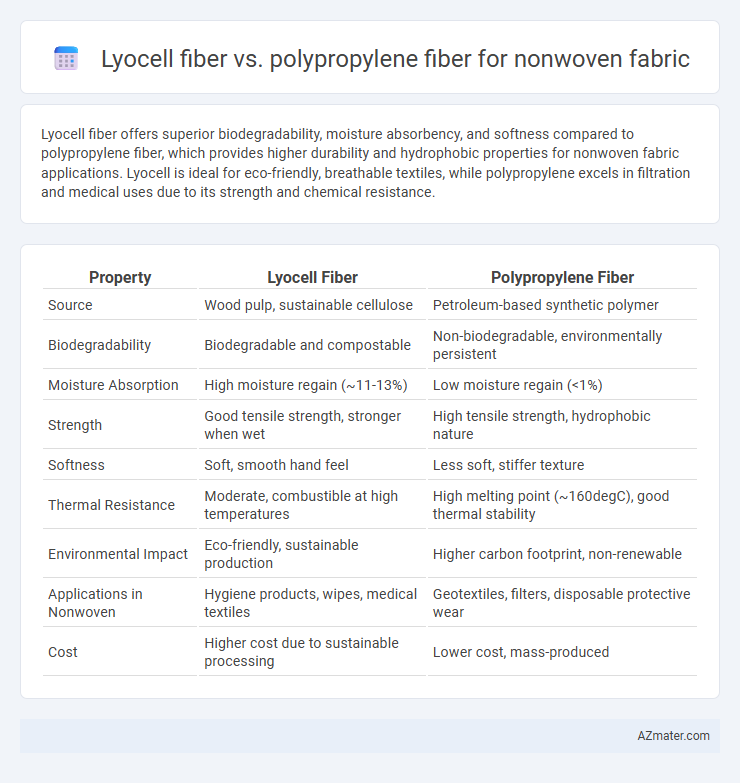Lyocell fiber offers superior biodegradability, moisture absorbency, and softness compared to polypropylene fiber, which provides higher durability and hydrophobic properties for nonwoven fabric applications. Lyocell is ideal for eco-friendly, breathable textiles, while polypropylene excels in filtration and medical uses due to its strength and chemical resistance.
Table of Comparison
| Property | Lyocell Fiber | Polypropylene Fiber |
|---|---|---|
| Source | Wood pulp, sustainable cellulose | Petroleum-based synthetic polymer |
| Biodegradability | Biodegradable and compostable | Non-biodegradable, environmentally persistent |
| Moisture Absorption | High moisture regain (~11-13%) | Low moisture regain (<1%) |
| Strength | Good tensile strength, stronger when wet | High tensile strength, hydrophobic nature |
| Softness | Soft, smooth hand feel | Less soft, stiffer texture |
| Thermal Resistance | Moderate, combustible at high temperatures | High melting point (~160degC), good thermal stability |
| Environmental Impact | Eco-friendly, sustainable production | Higher carbon footprint, non-renewable |
| Applications in Nonwoven | Hygiene products, wipes, medical textiles | Geotextiles, filters, disposable protective wear |
| Cost | Higher cost due to sustainable processing | Lower cost, mass-produced |
Introduction to Lyocell and Polypropylene Fibers
Lyocell fiber, derived from sustainably sourced wood pulp through a closed-loop solvent spinning process, offers high biodegradability and exceptional moisture absorption, making it ideal for eco-friendly nonwoven fabrics. Polypropylene fiber, a synthetic polymer made from propylene monomers, provides excellent chemical resistance, lightweight durability, and low cost, commonly used in industrial and medical nonwoven applications. Both fibers serve distinct roles in nonwoven fabric production, with Lyocell emphasizing sustainability and comfort, while Polypropylene highlights strength and economic efficiency.
Raw Material Sources and Sustainability
Lyocell fiber is derived from sustainably sourced wood pulp, primarily from eucalyptus, beech, and spruce trees processed through a closed-loop system that recycles water and solvents, minimizing environmental impact. Polypropylene fiber, a synthetic material produced from petrochemical resources, relies on non-renewable fossil fuels, contributing to carbon emissions and environmental pollution during production. Lyocell's biodegradability and renewable raw materials offer a significantly more sustainable alternative to polypropylene fibers, which persist in ecosystems and pose challenges for waste management.
Manufacturing Processes Compared
Lyocell fiber is produced through a closed-loop solvent spinning process that dissolves cellulose from wood pulp, resulting in environmentally friendly, biodegradable nonwoven fabrics with high breathability and moisture absorption. In contrast, polypropylene fiber is manufactured via melt spinning of polypropylene pellets, a petrochemical-derived polymer, offering cost-effective production and strong durability but limited biodegradability in nonwoven fabric applications. The lyocell manufacturing process involves solvent recovery systems that reduce emissions, whereas polypropylene fiber production emphasizes high throughput and uniform filament formation for industrial-scale nonwoven fabric manufacture.
Physical and Mechanical Properties
Lyocell fiber exhibits superior tensile strength, moisture absorption, and breathability compared to polypropylene fiber, making it highly suitable for nonwoven fabric applications requiring durability and comfort. Polypropylene fiber is known for its lightweight, hydrophobic nature, and excellent chemical resistance, contributing to enhanced water repellency and dimensional stability in nonwoven fabrics. The mechanical properties of Lyocell, such as elongation and tear resistance, outperform polypropylene, while polypropylene offers cost-effectiveness and resistance to UV degradation in nonwoven structures.
Environmental Impact and Biodegradability
Lyocell fiber, derived from sustainably sourced wood pulp, offers superior environmental benefits due to its closed-loop production process that recycles water and solvents, significantly reducing pollution compared to polypropylene fiber, which is petroleum-based and non-biodegradable. In terms of biodegradability, Lyocell decomposes naturally within weeks to months under composting conditions, contributing to lower landfill waste and reduced microplastic pollution, whereas polypropylene persists for decades, posing long-term environmental hazards. The eco-friendly profile of Lyocell clearly supports sustainable nonwoven fabric manufacturing, aligning with increasing regulatory and consumer demands for biodegradable and renewable materials.
Cost Efficiency and Economic Factors
Lyocell fiber, derived from sustainable wood pulp, offers higher production costs but delivers superior biodegradability and comfort in nonwoven fabrics, making it ideal for eco-conscious markets. Polypropylene fiber remains significantly cheaper with low raw material expenses and high-volume production, ensuring strong cost efficiency for disposable and industrial applications. Economic factors favor polypropylene for large-scale, cost-sensitive uses, while Lyocell provides value in premium, sustainable product lines despite higher investment.
Performance in Nonwoven Applications
Lyocell fiber offers superior moisture absorption and biodegradability, making it ideal for nonwoven applications requiring high breathability and eco-friendliness. Polypropylene fiber provides excellent chemical resistance, durability, and hydrophobic properties, excelling in filtration and medical nonwovens. Performance in nonwoven fabrics depends on specific application needs, with lyocell preferred for softness and sustainability, while polypropylene delivers strength and moisture barrier capabilities.
Comfort and Skin-Friendliness
Lyocell fiber offers superior moisture absorption and breathability compared to polypropylene fiber, enhancing comfort in nonwoven fabric applications. Its natural cellulose composition ensures softness and hypoallergenic properties, making it highly skin-friendly for prolonged contact. Polypropylene fiber, while durable and water-resistant, often lacks the same level of comfort and may cause irritation due to its synthetic nature and lower moisture management.
Typical Uses in Nonwoven Fabrics
Lyocell fiber is commonly used in nonwoven fabrics for hygiene products, medical dressings, and wipes due to its high absorbency, softness, and biodegradability. Polypropylene fiber is widely utilized in nonwovens for filtration, geotextiles, and industrial applications because of its strength, chemical resistance, and moisture repellency. Both fibers offer distinct benefits that influence their selection based on performance requirements and environmental considerations in nonwoven fabric production.
Future Trends in Nonwoven Fiber Technology
Lyocell fiber is gaining prominence in nonwoven fabric technology due to its biodegradability, superior moisture absorption, and softness, aligning with increasing sustainability demands in medical and hygiene applications. Polypropylene fiber remains a dominant choice for its cost-effectiveness, hydrophobic properties, and excellent durability, driving innovations in filtration and geotextiles. Future trends emphasize hybrid nonwovens combining Lyocell's eco-friendly attributes with Polypropylene's strength, advancing multifunctional materials with enhanced performance and environmental benefits.

Infographic: Lyocell fiber vs Polypropylene fiber for Nonwoven fabric
 azmater.com
azmater.com